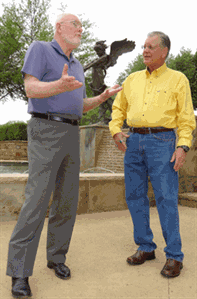A Tale of Two Eds – Heart Attack Success Story
A Tale of Two Eds
How one Ed’s story helped saved another Ed’s life
From the May/June edition of Richardson Living magazine
 Ed Woyewodzic (left) & Ed Curran, heart
Ed Woyewodzic (left) & Ed Curran, heart
attack survivors at Methodist Richardson
On Wednesday, March 28, two Richardson residents named Ed – Ed Woyewodzic and Ed Curran – met for the first time. The common denominator is that both Eds are heart attack survivors who were treated at Methodist Richardson Medical Center. But it was Woyewodzic's story that appeared in Methodist Health System's Shine magazine that played a huge part in saving Curran's life.
Curran read Woyewodzic's story on Nov. 1, and only a few days later experienced his own, milder heart attack symptoms.
"I thought I had indigestion, but since I had just read Ed's story, I told my wife I wanted to go to the emergency department at Methodist Richardson, and I'm so thankful I did," Curran said.
Within 34 minutes of arriving, Curran was revived after crashing, then taken to the cardiac catheterization lab where a stent was placed in his blocked artery, restoring blood flow to his heart.
"If I would have waited another 15 minutes, I probably would not be alive today," he said.
The two Eds' meeting was a joyful occasion. Both thankful for the angels above who looked over them the day of their heart attacks, it was only appropriate that they met for the first time in front of the angel statue at Methodist Richardson. The two immediately connected and began sharing their stories, comparing experiences, and thanking one another.
 Paying it forward
Paying it forward
When asked what message they'd like to leave with others who may one day experience the symptoms of a heart attack, they each said that time is of the essence.
"Every minute you're not getting treated, your heart is dying," Woyewodzic said. "If you even think you could possibly be having a heart attack, call 911 and let them start treating you en route to the hospital."
Curran emphasized the importance of noticing mild symptoms.
"My symptoms were not like the kind you see in the movies," he said. "I was not sweating or nauseated, I do not have any family history of heart disease, I do not take cholesterol or blood pressure medication, and I exercise and eat a healthy diet. But it still happened to me, and it can happen to anyone."
 From left Ed Woyewodzic, Nhan Nguyen, MD,
From left Ed Woyewodzic, Nhan Nguyen, MD,
independently practicing interventional cardiologist
and chief of staff at Methodist Richardson, and Ed Curran
Both Eds said they could not imagine what would have happened had they not come to Methodist Richardson.
As the meeting came to an end, Curran looked at Woyewodzic and said: "I'm sorry you had a heart attack, and I'm sorry I had one. But at least we can turn something good out of something bad and hopefully pay it forward by saving another life."
Quick Reference:
STEMI (ST-segment elevation myocardial infarction) – A total blockage in a coronary artery in the heart.
Door-to-balloon time – The time from when the patient arrives at the emergency department to when the interventional cardiologist opens up the blocked artery, restoring blood flow to the heart. The national standard for treating a STEMI patient is under 90 minutes.
SOAR time (symptom onset to arterial reperfusion) – The time from when a patient's heart attack symptoms start to when the interventional cardiologist opens up the blocked artery, restoring blood flow to the heart.
Success to share
- Methodist Richardson Medical Center has met the national standard for treating a STEMI patient within 90 minutes – door-to-balloon time – 100 percent of the time for nearly three years.
- In 2011, the hospital's average door-to-balloon time was 48 minutes.
- The American Heart Association Dallas Caruth Initiative recognized Ed Woyewodzic's case and awarded Methodist Richardson and the Richardson Fire Department with a SOAR award for having the fastest combined patient treatment time – 18 minutes door-to-balloon and a SOAR time of 43 minutes – which is significantly lower than Texas' median reported response time of 171 minutes.
- The fastest door-to-balloon time to date is a remarkable 17 minutes.

